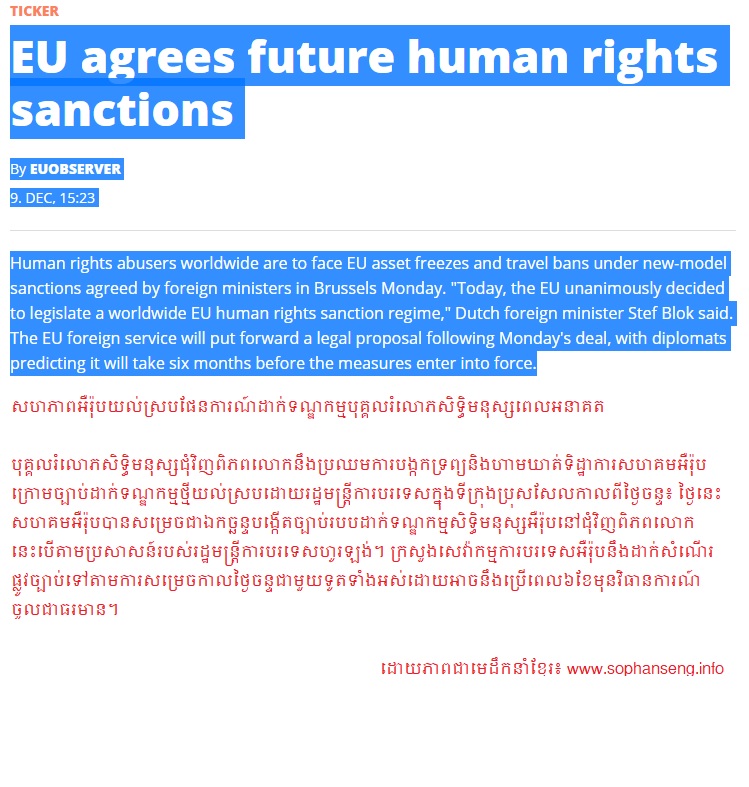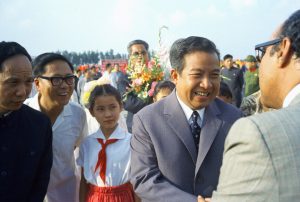A Jungle Airstrip Stirs Suspicions About China’s Plans for Cambodia
Source: the New York Time
Down the coast from Dara Sakor, American military officials say, China has reached a deal for exclusive rights to expand an existing Cambodian naval base, even as Beijing denies military intentions in the country.
“We are concerned that the runway and port facilities at Dara Sakor are being constructed on a scale that would be useful for military purposes and which greatly exceed current and projected infrastructure needs for commercial activity,” Lt. Col. Dave Eastburn, a Pentagon spokesman, said by email.
“Any steps by the Cambodian government to invite a foreign military presence,” Colonel Eastburn added, “would disturb peace and stability in Southeast Asia.”
The Chinese military’s “string of pearls” strategy depends on far-flung regional outposts. Some think Cambodia is becoming one.


By Hannah Beech
Photographs by Adam Dean
DARA SAKOR, Cambodia — The airstrip stretches like a scar through what was once unspoiled Cambodian jungle.
When completed next year on a remote stretch of shoreline, Dara Sakor International Airport will boast the longest runway in Cambodia, complete with the kind of tight turning bay favored by fighter jet pilots. Nearby, workers are clearing trees from a national park to make way for a port deep enough to host naval ships.

By The New York Times
The politically connected Chinese company building the airstrip and port says the facilities are for civilian use. But the scale of the land deal at Dara Sakor — which secures 20 percent of Cambodia’s coastline for 99 years — has raised eyebrows, especially since the portion of the project built so far is already moldering in malarial jungle.
The activity at Dara Sakor and other nearby Chinese projects is stirring fears that Beijing plans to turn this small Southeast Asian nation into a de facto military outpost.
Already, a far-flung Chinese construction boom — on disputed islands in the South China Sea, across the Indian Ocean and onward to Beijing’s first military base overseas, in the African Horn nation of Djibouti — has raised alarms about China’s military ambitions at a time when the United States’ presence in the region has waned. Known as the “string of pearls,” Beijing’s defense strategy would benefit from a jewel in Cambodia.
“Why would the Chinese show up in the middle of a jungle to build a runway?” said Sophal Ear, a political scientist at Occidental College in Los Angeles. “This will allow China to project its air power through the region, and it changes the whole game.”


As China extends its might overseas, it is bumping up against a regional security umbrella shaped by the United States decades ago. Cambodia, a recipient of Western largess after American bombs devastated its countryside during the Vietnam War, was supposed to be firmly ensconced in the democratic political orbit.
But to win his place as Asia’s longest-serving leader, Prime Minister Hun Sen of Cambodia has turned his back on free elections and rule of law. He excoriates the United States while warmly embracing China, which is now Cambodia’s largest investor and trading partner.
Down the coast from Dara Sakor, American military officials say, China has reached a deal for exclusive rights to expand an existing Cambodian naval base, even as Beijing denies military intentions in the country.
“We are concerned that the runway and port facilities at Dara Sakor are being constructed on a scale that would be useful for military purposes and which greatly exceed current and projected infrastructure needs for commercial activity,” Lt. Col. Dave Eastburn, a Pentagon spokesman, said by email.
“Any steps by the Cambodian government to invite a foreign military presence,” Colonel Eastburn added, “would disturb peace and stability in Southeast Asia.”


An American intelligence report published this year raised the possibility that “Cambodia’s slide toward autocracy,” as Mr. Hun Sen tightens his 34-year grip on power, “could lead to a Chinese military presence in the country.”
This month, the United States Treasury Department accused a senior general linked to Dara Sakor of corruption and imposed sanctions on him.
Mr. Hun Sen denies that he is letting China’s military set up in Cambodia. Instead, his government claims that Dara Sakor’s runway and port will transform this remote rainforest into a global logistics hub that will “make miracles possible,” as Dara Sakor’s promotional literature puts it.
Continue reading


